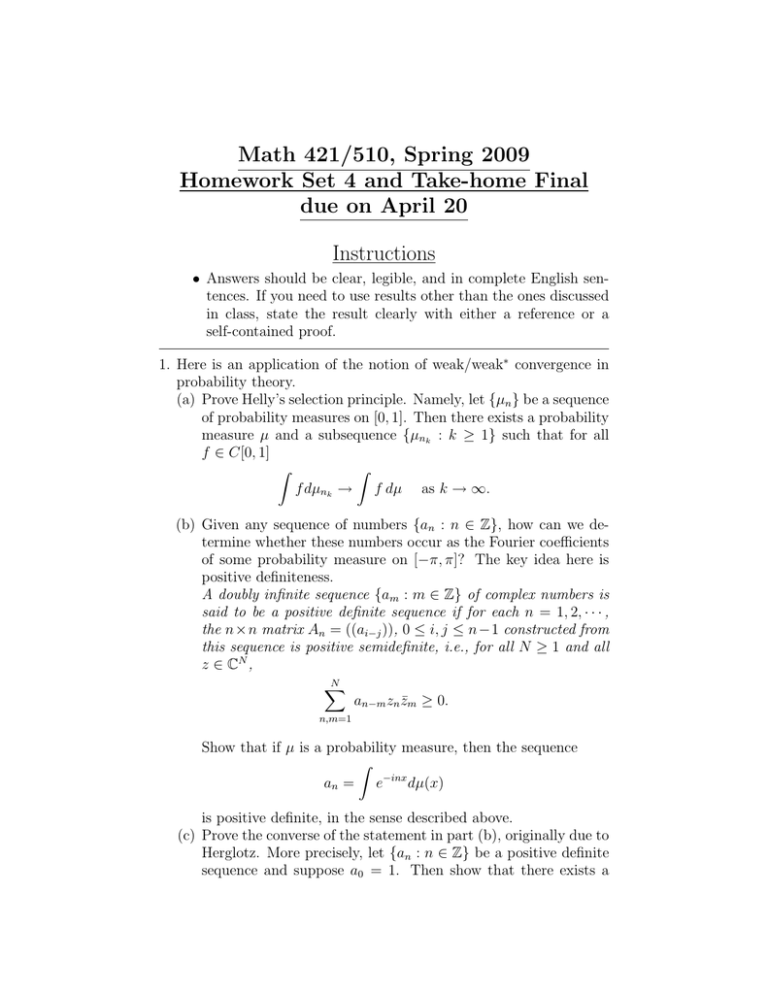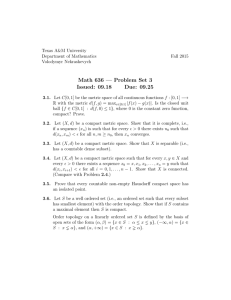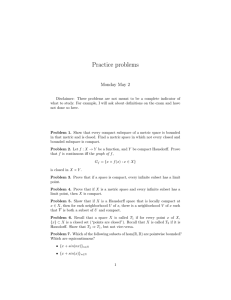Math 421/510, Spring 2009 Homework Set 4 and Take-home Final Instructions
advertisement

Math 421/510, Spring 2009
Homework Set 4 and Take-home Final
due on April 20
Instructions
• Answers should be clear, legible, and in complete English sentences. If you need to use results other than the ones discussed
in class, state the result clearly with either a reference or a
self-contained proof.
1. Here is an application of the notion of weak/weak∗ convergence in
probability theory.
(a) Prove Helly’s selection principle. Namely, let {µn } be a sequence
of probability measures on [0, 1]. Then there exists a probability
measure µ and a subsequence {µnk : k ≥ 1} such that for all
f ∈ C[0, 1]
Z
Z
f dµnk → f dµ as k → ∞.
(b) Given any sequence of numbers {an : n ∈ Z}, how can we determine whether these numbers occur as the Fourier coefficients
of some probability measure on [−π, π]? The key idea here is
positive definiteness.
A doubly infinite sequence {am : m ∈ Z} of complex numbers is
said to be a positive definite sequence if for each n = 1, 2, · · · ,
the n×n matrix An = ((ai−j )), 0 ≤ i, j ≤ n−1 constructed from
this sequence is positive semidefinite, i.e., for all N ≥ 1 and all
z ∈ CN ,
N
X
an−m zn z̄m ≥ 0.
n,m=1
Show that if µ is a probability measure, then the sequence
Z
an = e−inx dµ(x)
is positive definite, in the sense described above.
(c) Prove the converse of the statement in part (b), originally due to
Herglotz. More precisely, let {an : n ∈ Z} be a positive definite
sequence and suppose a0 = 1. Then show that there exists a
2
probability measure µ on [−π, π] such that
Z π
an =
e−inx dµ(x).
−π
2. We have seen that for a convex set K in a Banach space X, the
norm closure of K equals the weak closure of K. Is this statement
always true if K is a convex subset of U = X ∗ (for some Banach
space X) and “weak” is replaced by “weak∗ ”?
3. Is U = X ∗ equipped with the weak∗ topology metrizable?
4. Show that every normed linear space X is isometric to a subspace
of C(K) for some compact Hausdorff space K. If X is separable,
show that K can be chosen to be a compact metric space.
5. The previous exercise suggests that the spaces C(K) (of continuous
functions on a given compact Hausdorff space K) deserve special
attention, containing as they do isometric copies of every normed
linear space. Let us catalog some important properties of the spaces
C(K) for different choices of K.
Remember the Cantor middle-third set (we will denote this by
∆)? The goal of this problem is to uncover the “universal” nature
of C(∆). More precisely, we will prove that C(∆) is the “biggest”
among the spaces C(K), where K is a compact metric space. We
will do this by showing that every compact metric space K is the
continuous image of ∆.
(a) Convince yourself that the statement above is right, i.e., if ϕ :
∆ → K is a continuous surjection, then there exists a linear
isometry from C(K) to C(∆).
(b) Show that [0, 1] is a continuous image of ∆, as is the cube [0, 1]N .
(c) Recalling that the elements of ∆ are sequences of 0-s and 2-s,
i.e., ∆ = {0, 2}N , let us endow ∆ with the following natural
metric:
∞
X
|an − bn |
,
d(x, y) =
n
3
n=1
where {an } and {bn } are the sequences of digits (0-s and 2s) occurring in the ternary expansion of x and y respectively.
Convince yourself (but you need not submit a solution) that d
is equivalent to the usual metric on ∆. Moreover, d has the
additional property that d(x, y) = d(x, z) implies that y = z.
In subsequent discussions, take the metric on ∆ to be the one
described above.
Show that every compact metric space is homeomorphic to a
closed subspace of [0, 1]N .
3
(d) Deduce that every compact metric space K is the continuous
image of ∆. In light of part (a) of this problem, we now know
that C(K) is isometric to a closed subspace of C(∆).
6. OK, we have just now seen that C(∆) is “universal” for the class
of spaces C(K), for compact metric spaces K. In particular, C[0, 1]
sits inside C(∆)! This line of argument must seem backward, given
how much more publicity C[0, 1] receives than C(∆) (think of your
first course in analysis). Let’s ask whether C[0, 1] can be universal
too, i.e., whether C(∆) embeds isometrically into C[0, 1].
(a) Given a function f ∈ C(∆), define an extension f˜ of f as a
continuous function on [0, 1] so that the extension map E(f ) = f˜
from C(∆) into C[0, 1] is a linear isometry.
(b) Deduce that C(∆) is isometric to a complemented subspace of
C[0, 1]. (A subspace M is complemented in a Banach space X
if M is the range of a continuous linear projection P on X).
(c) Pull together the facts compiled in problems 4-6 to prove the
Banach-Mazur theorem: every separable normed linear space is
isometric to a subspace of C[0, 1].
7. Prove the spectral radius formula stated in class.
8. Find the spectra of the left shift operator L : `2 → `2 defined by
L(a0 , a1 , a2 , · · · ) = (a1 , a2 , · · · ),
and the Volterra operator V : C[0, 1] → C[0, 1] defined by
Z s
V x(s) =
x(r) dr.
0




